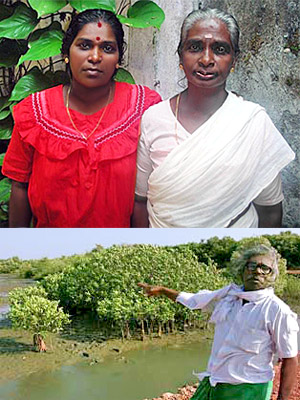 Pulayas are a part of the highly untouchable castes that were the last in the order of castes in the state of Kerala. This last group hides under its rags some very interesting features, since all the castes it comprises still carry on magical and shamanistic practices. They include the astrologer caste of Kanisans or Pannikars, the Vanans or washer men who claim powers of exorcizing diseases, the Pulayas who claim spiritual familiarity with the ancient serpent deities, and the Paraiyas, who are feared as sorcerers.
Pulayas are a part of the highly untouchable castes that were the last in the order of castes in the state of Kerala. This last group hides under its rags some very interesting features, since all the castes it comprises still carry on magical and shamanistic practices. They include the astrologer caste of Kanisans or Pannikars, the Vanans or washer men who claim powers of exorcizing diseases, the Pulayas who claim spiritual familiarity with the ancient serpent deities, and the Paraiyas, who are feared as sorcerers.
From the Pulayas and the Paraiyas were drawn the agrarian serfs of the lowlands; even below them were the miserable, unseeable Nayadis. The outcaste groups are led numerically by the Pulayas and the Paraiyas. Altogether these three groups comprise over eighty percent of the Hindu population in Kerala; the Pulayas are the oldest inhabitants of the lowlands of Kerala. Many of their customs resemble those of the hill tribes, and their legends claim that they were once independent and lived under a Pulaya king who ruled from a fort at the village of Pulayanarkotta in the hills close to Trivandrum. A further suggestion of their past importance is contained in the legend that Sri Padmanabhan, the avatar of Vishnu who reigns in the great Temple at Trivandrum, was discovered as an infant and nurtured by a Pulaya woman.
The people belonging to this community are well-known for their craftsmanship, music and for some specific dances which include Kolam-thullal. Kolam-thulla is a mask dance which forms a vital component of their exorcism rituals, and also the Mudi-attam or hair-dance which is linked to a fertility ritual. There are various other traditions of the Pulayas which include, the Theyyannam. It is a ritualistic dance which is done by the Kurava and Pulaya communities. There is a devotional offering made by the Pulayas called Bhadrakali thullal meant for their deity Bhadrakali. Especial pandals are erected in fields once the harvesting work is done and there the dances are executed.
There were certain hints of past wars between Pulayas and other Malayalis in a curious Saturnalian custom called Pula peddi which was abolished by a proclamation of the Raja of Venad as late as 1696. Pulapeddi was the privilege accorded to Pulayas at a certain season to molest women of higher castes whom they encountered after nightfall, either by abducting them or by casting stones or sticks so that, if hit, the women would feel polluted and on their own accord would leave their homes and join the outcastes. At the same time, the shamanistic practices of the Pulayas and other outcaste groups link them with a pre-Aryan and even pre-Dravidian magical culture. There seems little doubt of their descent from those remnants of the megalithic people who stayed in the lowlands to be enslaved by the Dravidian invaders, while their relatives in the hills retained a much greater degree of independence.









